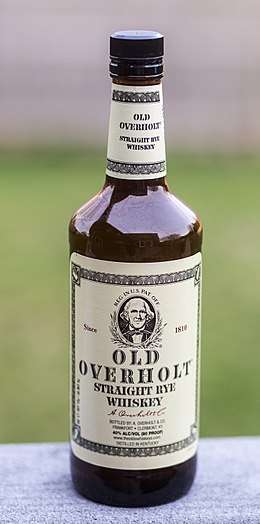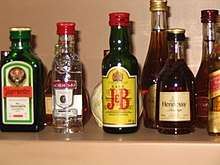Rye whiskey

Rye whiskey can refer to either of two, different, but related, types of whiskey:
- American rye whiskey, which must be distilled from at least 51 percent rye;
- Canadian whisky, which is often referred to as (and often labelled as) rye whisky for historical reasons, although it may or may not actually include any rye in its production process.
American rye whiskey
In the United States, "rye whiskey" is, by law, made from a mash of at least 51 percent rye. (The other ingredients of the mash are usually corn and malted barley.) It is distilled to no more than 160 U.S. proof (80% abv), and aged in charred, new oak barrels. The whiskey must be put into such barrels at not more than 125 proof (62.5% abv). Rye whiskey that has been so aged for at least two years and has not been blended with other spirits may be further designated as "straight", as in "straight rye whiskey".[1]
History
Rye whiskey was historically the prevalent whiskey of the northeastern states, especially Pennsylvania and Maryland. Pittsburgh was the center of rye whiskey production in the late 1700s and early 1800s.[2] By 1808, Allegheny County farmers were selling one half barrel for each man, woman and child in the country.[3] By the 1880s, Joseph F. Sinnott's distillery, Moore and Sinnott, located in Monongahela was the single largest producer of rye whiskey, with a capacity of 30,000 barrels a year.[4][5] Rye whiskey largely disappeared after Prohibition. A few brands, such as Old Overholt, survived it, although by the late 1960s even Pennsylvania names such as Old Overholt were being distilled mostly in Kentucky.[6] Today, an expanding number of brands are produced by Campari Group (Wild Turkey Rye), Diageo (George Dickel Rye and Bulleit Rye), Heaven Hill (Pikesville Rye and Rittenhouse Rye), Beam Suntory (Old Overholt and Jim Beam Rye), The Sazerac Company (Col. E. H. Taylor, Sazerac Rye, and Thomas H. Handy), and various smaller companies. One notable producer is MGP of Indiana, which is a distiller for many brands marketed by others (including some of the large companies previously listed).
Rye has been currently undergoing a small but growing revival in the United States.[7] Since the beginning of the 21st century, many more producers have been experimenting with rye whiskey, and several now market aged rye whiskey. For example, Brown-Forman has also begun production of a Jack Daniel's rye whiskey, releasing unaged and lightly aged as limited editions. A distillery at Mount Vernon, the homestead of George Washington, sells a rye that is said to be like what Washington made.[8]
Empire Rye
In October 2017, seven New York State distilleries unveiled a new whiskey style/category unique to the state called "Empire Rye."[9] To qualify as Empire Rye the whiskies must be made from at least 75% New York State-grown rye, be distilled at a single New York State distillery, be at least two years old, and be aged at the relatively low barrel entry proof of 115 or lower.[10] The original distilleries to produce Empire Rye were Black Button Distilling, Coppersea Distilling, Finger Lakes Distilling, Kings County Distillery, New York Distilling Co., Tuthilltown Spirits/Hudson Whiskey and Van Brunt Stillhouse.
Differences between rye and bourbon
Rye grain is known for imparting what many call a spicy or fruity flavor to the whiskey. Bourbon, distilled from at least 51% corn, is noticeably sweeter, and tends to be fuller bodied than rye. As bourbon gained popularity beyond the southern United States, bartenders increasingly substituted it for rye in cocktails like Whiskey sours, Manhattans, and Old Fashioneds, which were originally made with rye. All other things being equal, the character of the cocktail will be drier with rye.[11]
Canadian rye whisky
Canadian whisky is often referred to as "rye whisky", since historically much of the content was from rye. There is no requirement for rye to be used to make Canadian whisky, and the labels "Canadian whisky", "Canadian rye whisky" or "Rye whisky" are all legally permitted regardless of the actual composition, provided it "possess the aroma, taste and character generally attributed to Canadian whisky".[12]
In modern practice, most Canadian whiskies are blended to achieve this character, primarily consisting of a high-proof base whisky typically made from corn or wheat and aged in used barrels, together with a small amount of flavoring whisky made from a rye mash and distilled to a lower proof. In some cases the corn-to-rye ratio may be as high as 9:1.[13] Most contemporary Canadian whiskies contain only a fraction of rye, with the exception of a few brands, such as Alberta Premium and Canadian Club Chairman's Select, which are made from 100% rye mash.
Canadian whisky must be aged in wooden barrels that are not larger than 700 litres, 150 imp gal, 180 US gal for at least 3 years (although the barrels need not be new oak, nor charred). This requirement differs from regulations for U.S. blended whiskey, in which the bulk base spirits are not required to be aged.
See also
References
- ↑ ""Standards of Identity for Distilled Spirits", Title 27 Code of Federal Regulations, Pt. 5.22". U.S. Government Printing Office. Retrieved 2013-04-12.
- ↑ Toland, Bill (May 23, 2007). "Rye is Popular Again". Pittsburgh Post Gazette. Retrieved 2013-12-27.
- ↑ "Whiskey Resurrection: A Look at Local Distillers, and How They are Faring in Repeal's 4th Year". The Bulletin Index. September 16, 1937.
- ↑ New York Illustrated 1894. New York: AF Parsons Publishing Co. 1894. p. 250. Retrieved 18 April 2018.
- ↑ Hopkins, Kate (2009). 99 Drams of Whiskey: The Accidental Hedonist's Quest for the Perfect Shot and the History of the Drink. New York: St. Martin's Press. p. 196.
- ↑ "American Whiskey & How It Got to Be This Way". EllenJaye.com. Retrieved 2016-09-04.
- ↑ ""Rye's Revival", Wine Spectator magazine, July 31, 2008". Winespectator.com. Retrieved 2013-04-12.
- ↑ Mount Vernon Distillery accessed January 22, 2018
- ↑ Risen, Clay (2017-10-16). "You've Heard of Tennessee Whiskey? Meet New York State Rye". The New York Times. ISSN 0362-4331. Retrieved 2018-02-08.
- ↑ "Standards". Empire Rye. Retrieved 2018-02-08.
- ↑ See, e.g. Wondrich, David, Imbibe!: From Absinthe Cocktail to Whiskey Smash, a Salute in Stories and Drinks to "Professor" Jerry Thomas, Pioneer of the American Bar, Perigee Books, 2007. ( ISBN 978-0-399-53287-0) At page 241 Wondrich states, in giving the recipe for a Manhattan, that "[a]ll things being equal, a 100-proof rye will make the best Manhattan..."
- ↑ "Canadian Food and Drug Regulations (C.R.C., c. 870) - Canadian Whisky, Canadian Rye Whisky or Rye Whisky (B.02.020)". Laws.justice.gc.ca. Archived from the original on 2012-07-09. Retrieved 2013-04-12.
- ↑ ""Rye: Situation and Outlook", Agriculture and Agri-Food Canada, Bi-Weekly Bulletin, 2006-06-02 | Volume 19 Number 8 | ISSN 1494-1805 | AAFC No. 2081/E". Agr.gc.ca. 2011-01-30. Retrieved 2013-04-12.


